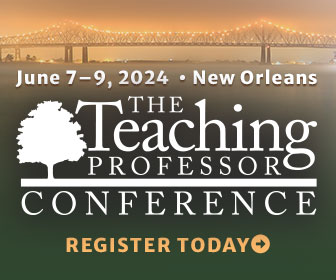The University of Wisconsin's Annual Conference on Distance Teaching and Learning is a good place to keep abreast of current trends in distance education. This year the two hottest topics were open education and mobile learning.
Open education
It's no secret that the growth of Massive Open Online Courses (MOOCs) has been front-page news in academia over the past year. Richard Baraniuk, director of the Center for Digital Learning and Scholarship at Rice University, expressed the views of many that fear of MOOCs has gotten out of hand. MOOCs are a wonderful way for universities to fulfill their mandate to advance the public good by generating and disseminating information. Not only does their online format break down barriers of space and time, but being offered for free also breaks down barriers of cost.
But isn't higher education giving away the store by offering instruction for free? Not exactly. Hundreds of years ago you had to go to a college to get the information that was stored in the heads of the faculty and transferred orally to students. But the printing press made that information available to everyone.
Colleges are no longer vaults of information. Everything a professor tells a student is available in some public form, be it academic journals, books, online, etc. Even if a professor comes up with some genuinely original insight, what is the first thing that they do? Publish it—they make it public. The same professors who are terrified about the possibility of making their material public have been racing to make it public for years.
But if the information is already available, then what does higher education add to the equation? Mostly the credential—the certification of a student's understanding via the degree. Try applying for an engineering job by listing the MOOCs that you sat in on and see how far you get.
In reality, MOOCs are no different from sophisticated textbooks (more on sophisticated textbooks below). In fact, if MOOCs are a threat, then the real threat to higher education is YouTube, since you can learn nearly anything from YouTube.
But the recent move into credit-bearing MOOCs raises some concerns. Their enrollment size precludes much interactivity or feedback, both of which are hallmarks of (good) online courses. The value of teachers is in their relationship to their students, and automating education removes that value.
Some defend credit-bearing MOOCs as a form of competency-based learning, with credits issued based on exams, similar to advanced placement tests. Unfortunately, MOOC detractors often paint all online courses with the same brush, which only adds fuel to general anti-online education sentiments. It will be interesting to watch how credit-bearing MOOCs shake out, as the battle may steer online education in general, for better or for worse.
Dr. Baraniuk also discussed how his open-source organization Connexions (
http://cnx.org) is offering online lecture content for free, and that these lectures have been downloaded more than 100 million times. Of course, free lecture content has been available from Open MIT, and a variety of colleges on iTunesU.
My own experience has been that faculty are generally reluctant to use this content because the lectures don't perfectly fit what they want to teach. Plus, the big schools like Stanford and MIT have generally just taped face-to-face lectures for content, which results in slow, boring, hard-to-hear lectures without any context. The benefit of organizations like Connexions is that they are starting to host content developed for the online medium itself. These are much higher-quality lectures, usually produced by little-known instructors at teaching colleges.
It's good to see that these higher-quality offerings are starting to gain traction. As José Antonio Bowen put it so well, our current system of having faculty members create their own lecture is like having every faculty member write his or her own textbook. If we did that, then 95 percent of textbooks would suck. As I like to say, if someone can say it better than you, then let them. As the breadth of good content increases, hopefully the problem with topic fit will diminish. Once this happens, teachers will focus less on just transferring their face-to-face lectures into an online environment and more on how to interact with students for personal feedback or create other ways to foster student engagement.
The open education movement is also branching into textbooks, which are offered free to students through a somewhat unclear relationship with sponsoring companies. The idea seems to be that companies that sell something of interest to students will pay for textbook development in return for access to that student. A physics textbook (in iBook form) might be paid for by a company that offers tutoring services to physics students, and they use the textbook to publicize that service.
While this is a nice way to reduce textbook costs, the model isn't fundamentally new. It just moves from funding textbooks with customer-generated revenue to funding them with advertising revenue. As Google taught us, you can make a billion dollars a nickel at a time through advertising revenue. Watch for an open textbook in your area.
Mobile
The second big topic this year is mobile learning. Higher education knows that we get most of our information on mobile devices today. Everyone knows that when you have dinner with five friends and someone says, “I thought that the Packers beat the Bears twice in '87,” someone will invariably whip out a cell phone to look it up. So why not offer course content in a similar on-demand fashion?
But incorporating mobile into learning has been a challenge. One early adopter simply assigned students to take photos around campus with their cell phones to illustrate a class concept. Not much of a pedagogical breakthrough.
My favorite use of mobile is to collect survey information from students and other audiences via feedback tools such as Poll Everywhere. These real-time polls motivate learning by getting students engaged in a question at the beginning. They are a great way to keep students' attention during class. They are also a good way to see if students are getting the point.
Another good use of mobile content is to create ebooks that can be played on a tablet. It's surprisingly easy to make ebooks. An advantage of ebooks over paper is that the instructor can embed features like quizzes, videos, and glossaries that link every instance of an unfamiliar term to its definition.
It occurred to me that ebooks would be a great alternative to PowerPoint for face-to-face lectures. The instructor can make each slide into an ebook page to project to the audience and then run embedded quizzes, videos, polls, and other content as they go along. Better yet, the instructor can send the students the same version for them to run on their tablets while the instructor is speaking or, if they do not have a tablet, to run a PDF version on any device. The advantage is that students can annotate their version with comments, highlights, etc., as they follow along. This connects their notes directly to the original content to which the notes refer. That would be a huge advantage when studying.
So the takeaways from Madison were A) look for open education resources to complement your material; B) consider ways to incorporate mobile into your teaching; and C) make sure to order the six-brew sampler at the Great Dane. You heard it here first.





